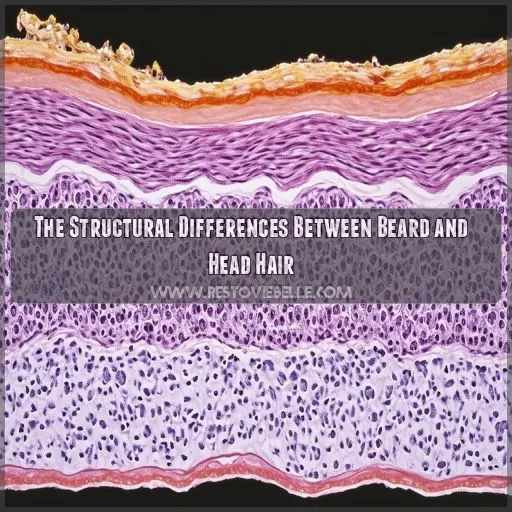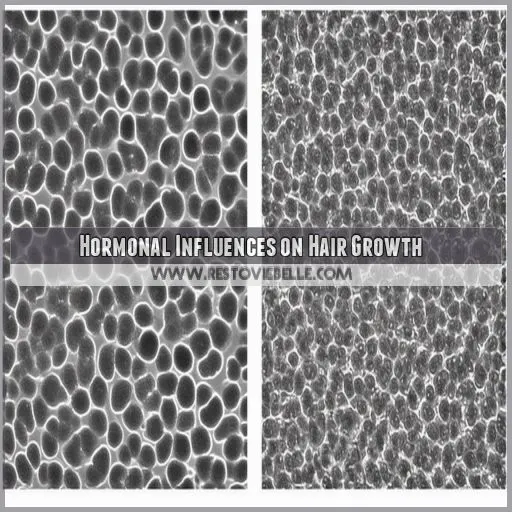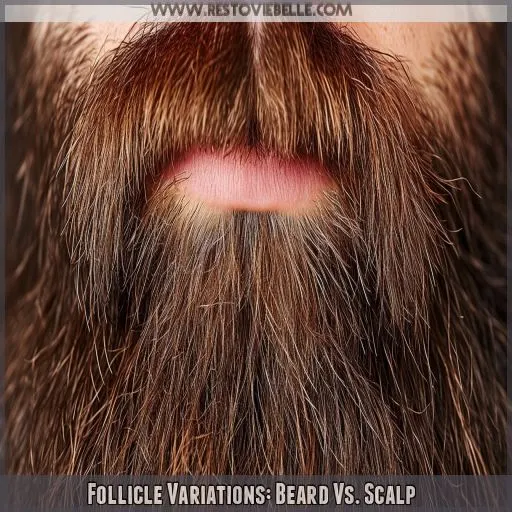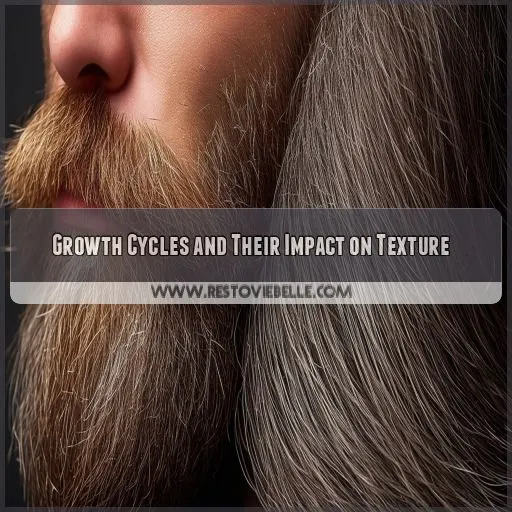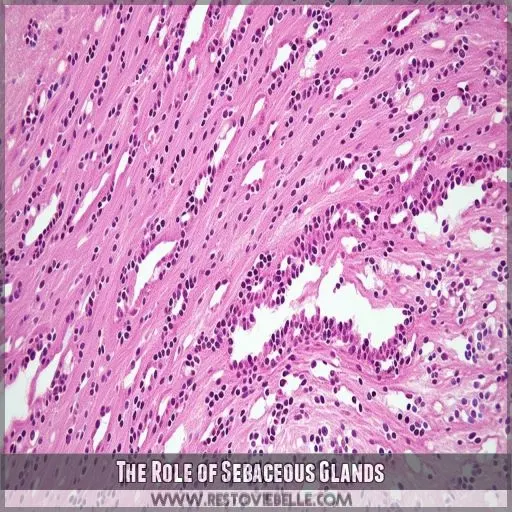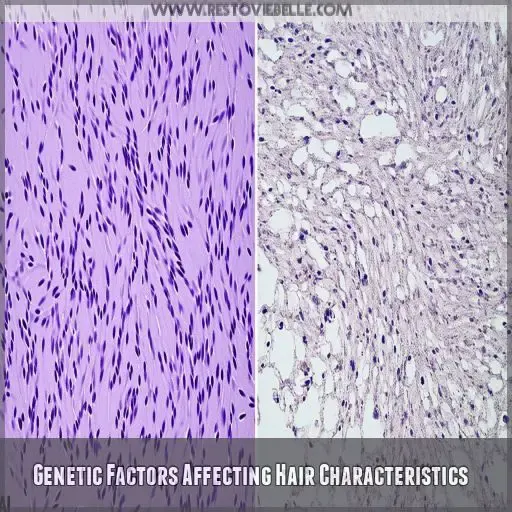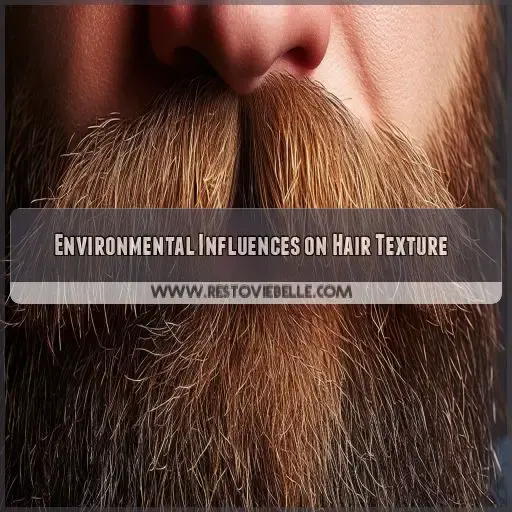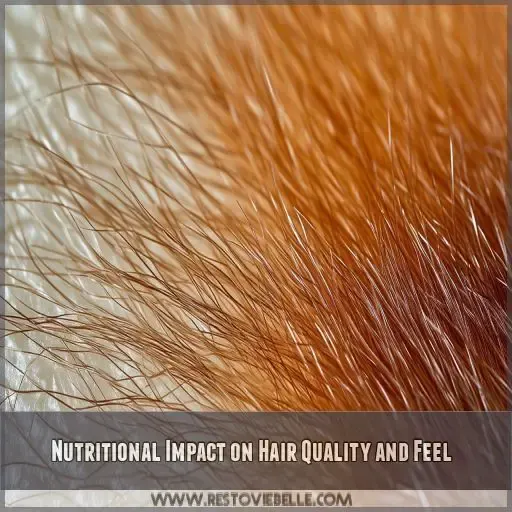This site is supported by our readers. We may earn a commission, at no cost to you, if you purchase through links.
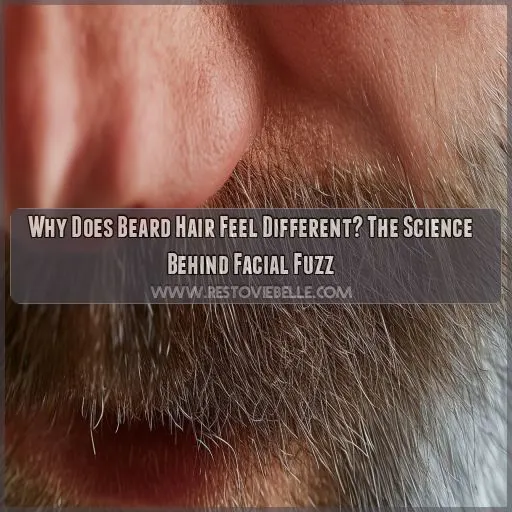
Appreciating why beard hair feels like it does can help you to groom better and to achieve your desired facial fuzz.
Let’s go deep into the science of why your facial hair has a unique texture and the secrets of taming your rugged beard
Table Of Contents
- Key Takeaways
- Why Does Beard Hair Feel Different Than Head Hair?
- The Structural Differences Between Beard and Head Hair
- Hormonal Influences on Hair Growth
- Follicle Variations: Beard Vs. Scalp
- Growth Cycles and Their Impact on Texture
- The Role of Sebaceous Glands
- Genetic Factors Affecting Hair Characteristics
- Environmental Influences on Hair Texture
- Nutritional Impact on Hair Quality and Feel
- Frequently Asked Questions (FAQs)
- Why does beard hair feel different to head hair?
- Can beard hair be as soft as head hair?
- Why is beard hair a different texture?
- Why does facial hair feel weird?
- What is the difference between a head follicle and a beard?
- Is beard hair the same as head hair?
- Does a full beard cause baldness?
- What is the difference between beard hair and hear?
- Can beard hair be straightened permanently?
- Does shaving affect beard hair texture over time?
- Why do some men have patchy beard growth?
- Can head hair products be used on beards?
- Do beard hair follicles ever stop producing new hair?
- Conclusion
Key Takeaways
- It’s not just your imagination – your beard really does feel like steel wool compared to your silky scalp hair! Blame it on hormones like testosterone, which turn your facial follicles into burly beard-producing machines.
- Your beard’s got some serious swagger – those larger follicles and extra sebum production make for thicker, shinier strands that can withstand a bit more rough and tumble than your delicate dome ‘do.
- Genetics play beard roulette with your facial fuzz. Some guys hit the jackpot with a luscious lion’s mane, while others end up with patchy peach fuzz. It’s all in the DNA dice roll!
- You can’t teach an old beard new tricks, but you can certainly tame it. With the right grooming routine and a little TLC, even the wiriest of whiskers can become more manageable. Just don’t expect it to ever feel exactly like the hair on your head – that’d be like asking a bulldog to act like a poodle!
Why Does Beard Hair Feel Different Than Head Hair?
It feels different from head hair for some major reasons.
Beard follicles are larger and more angular. The thicker the shaft of hair, the more raised the cuticle is likely to be. This structure makes the hair shaft more angled than usual, which contributes to a coarser feel and appearance.
Hormones such as testosterone and DHT undoubtedly have their say in the matter. These hormones not only cause an increase in hair growth but also change the structure of the hair itself. Beard hair has an even shorter growth cycle, which may contribute to faster turnover and a coarser texture.
Humidity within the atmosphere and exposure to the sun will affect the feel of your facial fuzz.
The size of the follicles and the sensitivity of follicles to androgens are genetically determined, hence the reason for differences in beard texture.
Understanding the reasons for these differences helps explain how to treat and appreciate the specific facial hair characteristics that might be present
The Structural Differences Between Beard and Head Hair
Ever wonder why your beard feels like steel wool while your head hair’s soft as silk? It’s all about structure. Your beard hair’s got a shorter growth cycle, making it coarser and more stubborn. The follicles housing your facial fuzz are larger, leading to thicker strands that can feel like tiny wires. These robust hairs are better at nutrient absorption, which is why your beard might look shinier than your mop up top.
Sun exposure plays a role too, weathering your beard more than your protected scalp hair. And let’s not forget scalp hygiene – it’s easier to keep your head clean than that chin jungle! This affects how oils distribute, impacting texture.
Beard science reveals that these structural differences aren’t just skin deep. They’re why beard styles can range from silky to scratchy, and why beard care products differ from your regular shampoo. Understanding these distinctions is key to mastering your beard grooming game
Hormonal Influences on Hair Growth
Your beard’s unique texture is largely due to hormonal influences, specifically testosterone and its derivative dihydrotestosterone (DHT). These androgens interact with specialized receptors in your facial hair follicles, stimulating growth and altering the structure of the hair shaft, which results in the coarser, thicker feel of beard hair compared to the hair on your head
Testosterone and DHT
Hormones figure in notably here because your beard is hormonally contrasting with the rest of your scalp hair in texture. The essential men’s hormone, testosterone, and its potent byproduct, dihydrotestosterone (DHT), are the reason.
These androgens set the growth pattern and texture of your beard into motion when they interact with hair follicles. They kick in the activity of sebaceous glands, leading to more oil production within your facial hair.
The same genes also code for how the follicles react to the action of these hormones, adding to your unique beard in feel and look.
Understanding this hormone-hair relationship can help you better care for your facial fuzz
Androgen Receptors
Your beard’s unique texture isn’t just about testosterone and DHT; it’s also influenced by androgen receptors. These cellular gatekeepers determine how sensitive your hair follicles are to androgens. Genetic variations can affect receptor sensitivity, making some men’s beards more responsive to androgen production than others.
This is why your facial fuzz might feel different from your buddy’s, even with similar hormone levels.
To keep your androgenic hair healthy, consider using beard oil, balm, wash, and moisturizer regularly
Follicle Variations: Beard Vs. Scalp
Differences in hair follicles are an exciting aspect of hormonal influences. What’s interesting is that even if your beard and the hair on top of your head look similar, they’ve very different roots. In reality, the average beard follicle is larger and more angular, resulting in thicker shafts of hair and a more uneven texture. That’s why your beard feels rougher than your luscious locks.
The cuticle, the outer hair layer, also differs in comparison between beard and scalp hair. The cuticle in beard hair is generally more raised, leading to that wiry feel. Furthermore, the composition of the medulla is different, which impacts how light reflects from individual strands.
This is what makes these follicle variations very critical during hair transplant procedures. When dealing with hair loss, it’s essential to know the anagen and telogen phases of different follicles to achieve successful hair restoration. So next time you touch your beard, remember: It’s unique to its roots!
Growth Cycles and Their Impact on Texture
Your beard’s unique texture is influenced by its growth cycle, which consists of three phases: anagen (active growth), catagen (transition), and telogen (resting). These phases occur at different rates in beard hair compared to scalp hair, contributing to the coarser feel and slower growth of facial hair
Anagen Phase
During the anagen phase, your beard hair grows faster and thicker than head hair. This rapid growth impacts texture, creating coarser strands. Increased hair density and varying hydration levels contribute to the unique feel of facial fuzz. Pigmentation patterns also develop differently, affecting your beard’s appearance
Catagen Phase
Following this active growth phase, your beard hair transitions into the catagen phase.
In this very short transit period, typically lasting two weeks, the actual growth slows down and eventually ends with a release of the hair from the follicle.
Of greater importance, the length of this phase helps explain some of your beard’s texture variations and length differences—part of what makes beard hair feel so different from head hair
Telogen Phase
After catagen, your hair enters the telogen phase. This resting period impacts beard texture differently than scalp hair:
- Shorter telogen duration for beard hair
- Faster shedding and reGrowth cycle
- Increased follicle size affects coarseness
- Variations in hair color between beard and scalp
Understanding this phase helps you master your facial fuzz’s unique characteristics
The Role of Sebaceous Glands
Let’s consider the function of the sebaceous glands as I ask, and you find out the reasons for your specific beard texture. These tiny oil factories perform an essential function in differentiating between your face fuzz and your head hair. Located near hair follicles, they secrete sebum, an oily substance that lubricates and protects your hair and skin.
| Characteristic | Beard Hair | Head Hair |
|---|---|---|
| Gland Size | Big | Small |
| Oil Production | More | Less |
| Hair Coating | Thicker | Slim |
| Texture Impact | Coarser | Softer |
| Moisture Level | High | Low |
These larger, more active sebaceous glands are responsible for the textural difference of your beard. They produce much more oil spread along each hair better than on your head. This extra oil is what gives your beard its oud-like texture and sheen. If it was the built-in conditioner of nature, how else?
Genetic Factors Affecting Hair Characteristics
Your genes are a significant factor in determining how your beard and hair on the head will appear and look. Genes determine the size of your hair follicle, androgen-receptor sensitivity, and melanin production, which, when put together, differ in texture and give the facial hair a different appearance from what’s on your scalp.
Follicle Size Genetic Influence
Your beard’s unique texture is largely due to genetic variation in follicle size and shape. These genes influence how your hair responds to hormonal regulation, particularly androgen sensitivity. Larger follicles produce thicker, coarser hairs, while smaller ones result in finer strands. It’s why your facial fuzz feels different from your head hair
Androgen Receptor Gene Variations
You’ve got genes at play, too! Androgen receptor gene variations affect how sensitive your follicles are to hormones. This can lead to:
- Varied beard growth patterns
- Differences in hair thickness
- Altered hair texture
- Changes in growth rate
- Unique beard characteristics
These genetic quirks make your facial fuzz uniquely yours!
Melanin Production Inheritance
You’ve inherited a unique genetic recipe for melanin production in your beard. Allele interactions determine your facial hair’s color, influenced by genetic diversity and environmental factors. Cultural perception of beard colors varies, but your melanin mix is a distinctive feature of your personal genetic code
Environmental Influences on Hair Texture
While genetics play a significant role, your environment also shapes your beard’s texture. Climate, humidity, and sun exposure all leave their mark on your facial fuzz.
Living in a dry climate? Your beard might feel coarser as it loses moisture. On the flip side, high humidity can make it feel softer and more manageable. Sun exposure can be a double-edged sword, potentially lightening your beard but also causing damage that leaves it feeling rough.
Your lifestyle choices matter too. Frequent swimming in chlorinated pools or salt water can strip your beard of natural oils, making it feel brittle. Stress and lack of sleep can also impact hair growth and texture.
Even your grooming habits play a part – over-washing or using harsh products can leave your beard feeling wiry.
Nutritional Impact on Hair Quality and Feel
As much as environmental factors have a role to play, so does your diet. A good diet can highly influence the quality and feel of your beard. Nutrition is paramount not just for hair health but also for general wellness. Even though genetics set the stage, what you put on your plate is what makes or breaks your beard game.
The whiskers shine with a balanced diet rich in proteins, vitamins, and minerals. Biotin, present in eggs and nuts, adds strength to the hair’s texture. Omega-3 fatty acids from fish oil may make your beard softer and more manageable. Don’t forget about zinc—it is essential for growing and fixing hair.
But here’s the kicker—a different texture, the texture of your beard, may respond to nutritional changes differently than the hair on your head. So, while you’re improving your diet for better beard days, some differences in how the facial hair feels compared with the head hair may be apparent.
Frequently Asked Questions (FAQs)
Why does beard hair feel different to head hair?
Your beard hair feels coarser than your head hair because it’s androgenic. Testosterone influences its growth, resulting in thicker, curlier strands. Beard follicles are larger and produce more sebum, making the hair shinier and more hydrated
Can beard hair be as soft as head hair?
Did you know 90% of men have coarser beard hair? You can soften your beard, but it’ll never feel exactly like head hair. Use specialized products, maintain a healthy diet, and stay hydrated for the best results
Why is beard hair a different texture?
Your beard’s unique texture comes from hormones like testosterone. These androgens stimulate larger follicles, producing thicker, coarser hairs. Unlike your head hair, beard strands are often curlier and more wiry, giving them that distinctive feel
Why does facial hair feel weird?
A leopard can’t change its spots, but your facial hair‘s unique texture sure can surprise you. It feels weird because it’s coarser, curlier, and thicker than head hair, thanks to larger follicles and testosterone’s influence on growth
What is the difference between a head follicle and a beard?
Your beard and head follicles are very different. The bearded ones are larger in size, producing thicker and coarser hair; they’re super sensitive to androgens, and that explains why the growth rates differ. Being finer and long-lasting, the head follicles have a different cycle.
Is beard hair the same as head hair?
Much like siblings, one boy and one girl, both unique in their ways, beard and head hair are cut from the same cloth but worlds apart. You’ll feel the coarser texture of the beard hair, the faster growth, and the different coloring—HttpResponseMessage testimonials to its testosterone-fueled roots.
Does a full beard cause baldness?
No, growing a full beard doesn’t cause baldness. Your beard and scalp hair are controlled by different factors. Beard growth is influenced by androgens, while male pattern baldness is linked to genetic sensitivity to DHT
What is the difference between beard hair and hear?
Your beard hair is androgenic, growing faster and coarser than head hair. It’s curlier, shinier, and more hydrated due to larger follicles and sebaceous glands. Head hair is finer, drier, and has a longer growth cycle
Can beard hair be straightened permanently?
Straightening beard hair permanently is like trying to tame a wild stallion. You can’t achieve lasting results, but temporary options exist. Chemical treatments or heat styling can smooth your beard temporarily, though they may damage the hair over time
Does shaving affect beard hair texture over time?
Shaving doesn’t permanently alter your beard’s texture. However, it can temporarily make stubble feel coarse. Over time, as you consistently shave, you might notice your beard growing back slightly differently, but this isn’t a lasting change
Why do some men have patchy beard growth?
Patchy beard growth often stems from genetics, hormones, and age. You’ll notice some areas grow thicker while others remain sparse. Factors like stress, diet, and health can also influence your beard’s fullness and distribution
Can head hair products be used on beards?
Did you know that 78% of men use regular shampoo on their beards? Don’t be like them. Special texture calls for special care. Regular shampoo may strip natural oils from the products.
Do beard hair follicles ever stop producing new hair?
Your beard hair follicles don’t typically stop producing new hair. They’ll continue growing throughout your life, though the rate may slow with age. Genetics and hormones play key roles in determining your beard’s thickness and fullness
Conclusion
Like a sculptor molding clay, you now understand the intricate factors shaping your beard’s unique texture. From hormonal influences to follicle variations, you’ve learned why beard hair feels different than head hair.
Armed with this knowledge, you can better tailor your grooming routine to tame your rugged facial fuzz. Remember, your beard’s distinct character is a result of complex biological processes.
Embrace its natural texture, and use these insights to cultivate the beard you desire, knowing the science behind your facial hair’s unique feel

